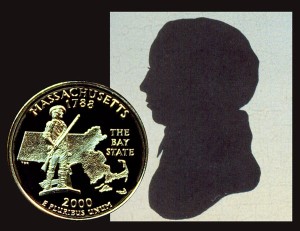Today, the Massachusetts State Quarter Coin remembers the incorporation of what would become the first millworks using power to manufacture cotton from the bolls to woven cloth.
The American Wool and Cotton Reporter of April 13, 1916 included an article—Boston, the Pioneer in Textile Manufacturing.
This article included a description of the first power mill, which was incorporated in Waltham, Massachusetts 203 years ago.
=====
Boston capital was employed in establishing mills near that city, which are at the present time among the well-known mills of the country.
The Boston Manufacturing Company, located at Waltham, Mass., was established by the original enterprise of Francis Cabot Lowell and Patrick Tracy Jackson.
The Boston Manufacturing Company was the first mill in the world in which the complete operation of manufacturing cotton was done by power.
It was incorporated February 23, 1813, and capitalized at $400,000.
Lowell, for whom the City of Lowell is named, had previously informed himself in methods of textile manufacturing in England.
Mr. Lowell was a wealthy Boston merchant, who proposed to build this mill in order to accomplish entirely by power what had formerly been done by hand.
It was found that money could be saved by spinning the twist rather than by purchasing it, so the mill was constructed with an equipment of 1700 spindles.
As Mr. Lowell was one of the founders of the textile industry in this country, a note of his work is not inappropriate at this time.
He was born in Newburyport, Mass., April 7, 1775. He was a graduate of Harvard College in the class of 1793.
In 1811 he visited England and Scotland. While at Edinburgh he met Nathan Appleton, whom he told that he thought that cotton manufacturing should be carried on in America and not monopolized by England as it was at that time.
Mr. Appleton, after Mr. Lowell had told him that he intended to go to Manchester for investigation in cotton machinery, promised his cooperation, and in fact urged him to go to that city.
He did so, and succeeded in securing valuable information in regard to the machines which were so closely guarded. He found out enough about them to make them.
He discussed the situation in America with Patrick Tracy Jackson, who was his brother-in-law and a wealthy Boston merchant.
The outcome of their conference was that Mr. Jackson decided to embark in the new enterprise which Mr. Lowell proposed.
Water power rights at Waltham were purchased of John Boles’ Paper Mill. The company was incorporated in the year 1813 as the Boston Manufacturing Co.
Although the authorized capital was $400,000, only $100,000 was to be actually paid until the experiment had been found successful.
Mr. Lowell and Mr. Jackson bought most of the stock, but Nathan Appleton invested $5,000.
Mr. Lowell at once devoted his time to inventing a power loom. He was assisted by Paul Moody, of Amesbury.
A store on Broad street, Boston, was the scene of the experiments which were carried on in connection with making this power loom.
In the autumn of 1814 the loom was finished and put into the new mill. The original structure was five stories high, 45 feet wide and 90 feet long.
It was equipped with 3,000 spindles, producing 4,000 yards per week.
Without doubt February 2, 1816, according to a record on the books of the company, was the earliest date when power was used to produce the first cotton cloth with the whole manufacture carried on in the same building.
The entry was 1,242 yards, 4-4, or 36 inches wide cotton. It was necessary to have an apparatus for winding the threads from the bobbins onto the beam, and for this Mr. Moody invented the warper.
There was also great necessity for a bobbin and fly for spinning roving.
The double speeder was invented for this by Mr. Lowell and Mr. Moody.
Mr. Lowell was a brilliant mathematician, and his ability in this direction served him in good stead in his calculations in connection with the speeder.
Later there was some litigation in regard to the patent, and William Bowditch, the mathematician, was much surprised that anyone beside himself could handle the problems necessary in connection with the speeder.
The textile industry of the present day owes a great deal to Lowell and Moody for their work on this machinery.
Once the Waltham mill was started it became successful, and the whole amount of capital, or $400,000, was quickly secured.
As during the present time, on account of the European War, the War of 1812 was a great influence in requiring more American textiles.
After the War of 1812 was finished, many foreign goods were sent into this country and sold at a very cheap price.
This was particularly hard for the industry, because the power loom was not in general use.
Mr. Lowell went to Washington in regard to the matter, and in 1816 Congress voted to impose a duty of 6.25 cents per square yard.
Mr. Lowell was one of the most noted men in the textile industry in the early days to whom the present manufacturers owe a great deal, particularly in the mill organization as inaugurated by him.
Mr. Lowell was also interested in establishing other mills.
…
=====
The Massachusetts State Quarter Coin shows beside an outline image of Francis Cabot Lowell, only known image of the man.
